Graeme Hart: The Richest New Zealand Entrepreneur and His Strategies
VerifiedAdded on 2023/04/21
|11
|2570
|308
Report
AI Summary
This report provides a comprehensive analysis of Graeme Hart, the richest entrepreneur in New Zealand. It delves into his background, entrepreneurial characteristics, including vision, adaptability, and risk-taking abilities. The report examines Hart's opportunity recognition skills, particularly his application of the Innovation Value Chain, and his ability to identify and acquire underperforming companies. It further explores his competitive advantages, highlighting his success with the Rank Group and its subsidiaries, Reynolds Group and Carter Holt Harvey. Finally, the report offers strategic recommendations for Hart, including the importance of market research, competitor analysis, and maintaining a balance in his core business operations. The report emphasizes Hart's significant impact on the business landscape and his influence on the New Zealand economy, offering valuable insights into his methods and strategies for future success.
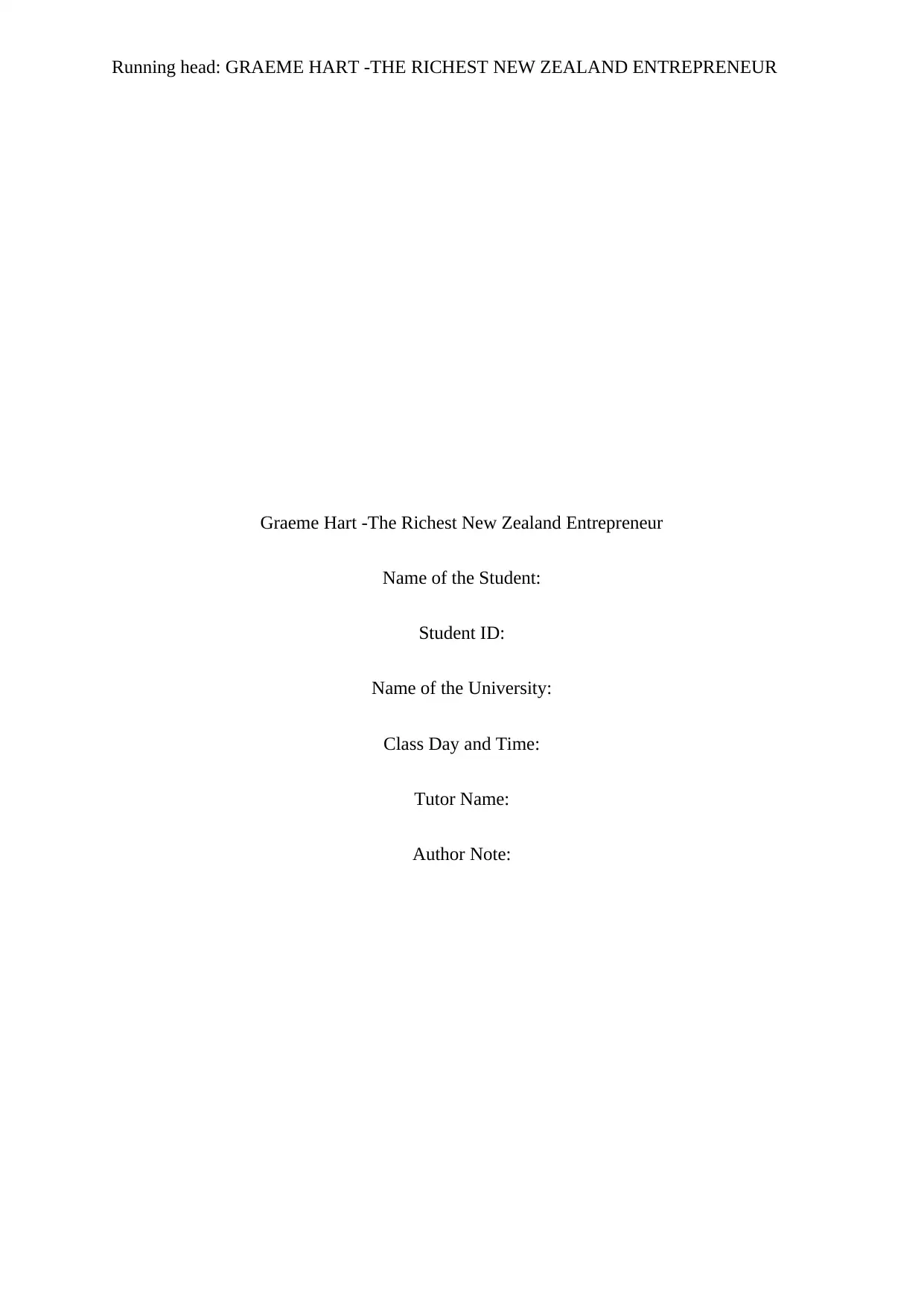
Running head: GRAEME HART -THE RICHEST NEW ZEALAND ENTREPRENEUR
Graeme Hart -The Richest New Zealand Entrepreneur
Name of the Student:
Student ID:
Name of the University:
Class Day and Time:
Tutor Name:
Author Note:
Graeme Hart -The Richest New Zealand Entrepreneur
Name of the Student:
Student ID:
Name of the University:
Class Day and Time:
Tutor Name:
Author Note:
Paraphrase This Document
Need a fresh take? Get an instant paraphrase of this document with our AI Paraphraser
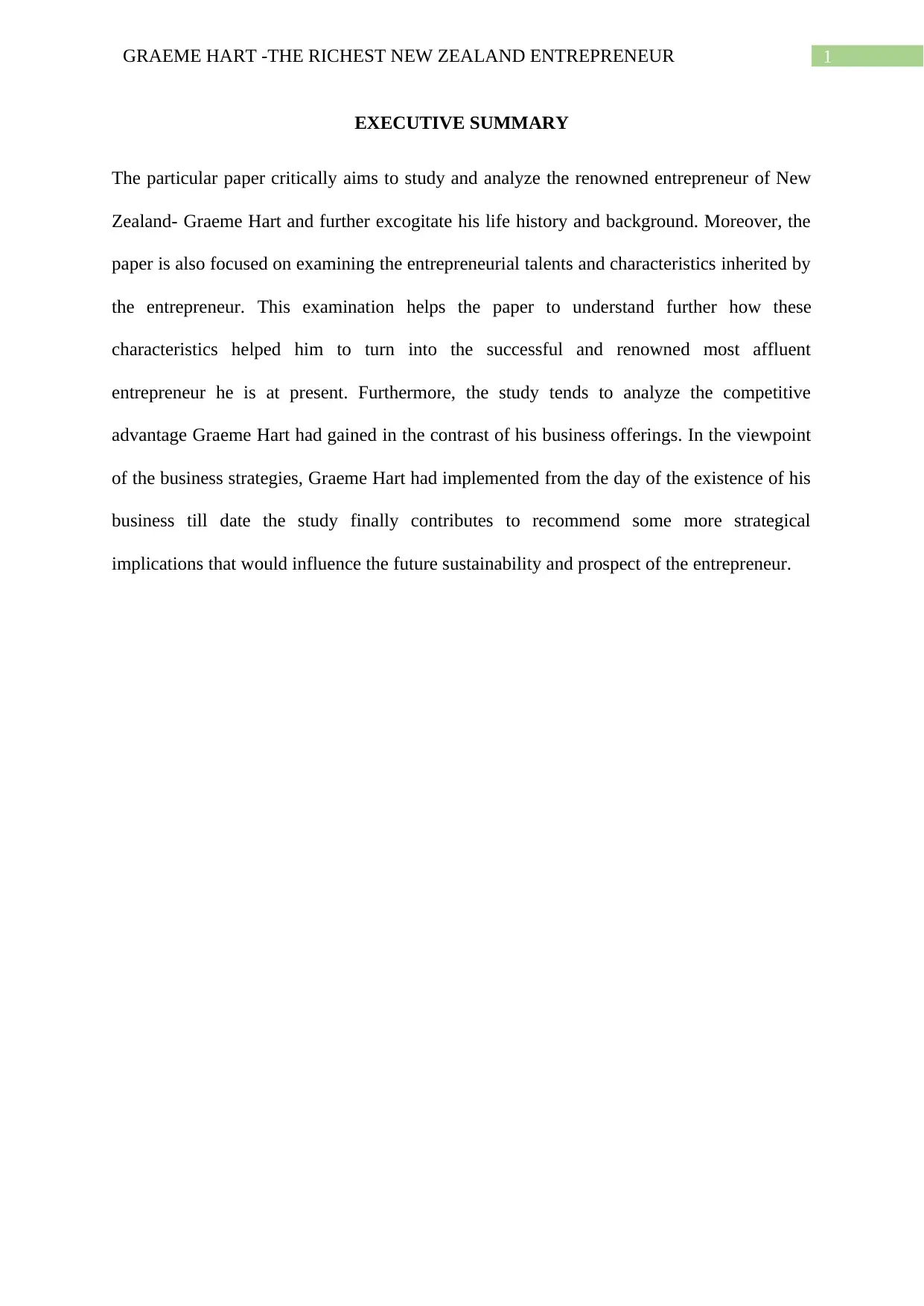
1GRAEME HART -THE RICHEST NEW ZEALAND ENTREPRENEUR
EXECUTIVE SUMMARY
The particular paper critically aims to study and analyze the renowned entrepreneur of New
Zealand- Graeme Hart and further excogitate his life history and background. Moreover, the
paper is also focused on examining the entrepreneurial talents and characteristics inherited by
the entrepreneur. This examination helps the paper to understand further how these
characteristics helped him to turn into the successful and renowned most affluent
entrepreneur he is at present. Furthermore, the study tends to analyze the competitive
advantage Graeme Hart had gained in the contrast of his business offerings. In the viewpoint
of the business strategies, Graeme Hart had implemented from the day of the existence of his
business till date the study finally contributes to recommend some more strategical
implications that would influence the future sustainability and prospect of the entrepreneur.
EXECUTIVE SUMMARY
The particular paper critically aims to study and analyze the renowned entrepreneur of New
Zealand- Graeme Hart and further excogitate his life history and background. Moreover, the
paper is also focused on examining the entrepreneurial talents and characteristics inherited by
the entrepreneur. This examination helps the paper to understand further how these
characteristics helped him to turn into the successful and renowned most affluent
entrepreneur he is at present. Furthermore, the study tends to analyze the competitive
advantage Graeme Hart had gained in the contrast of his business offerings. In the viewpoint
of the business strategies, Graeme Hart had implemented from the day of the existence of his
business till date the study finally contributes to recommend some more strategical
implications that would influence the future sustainability and prospect of the entrepreneur.
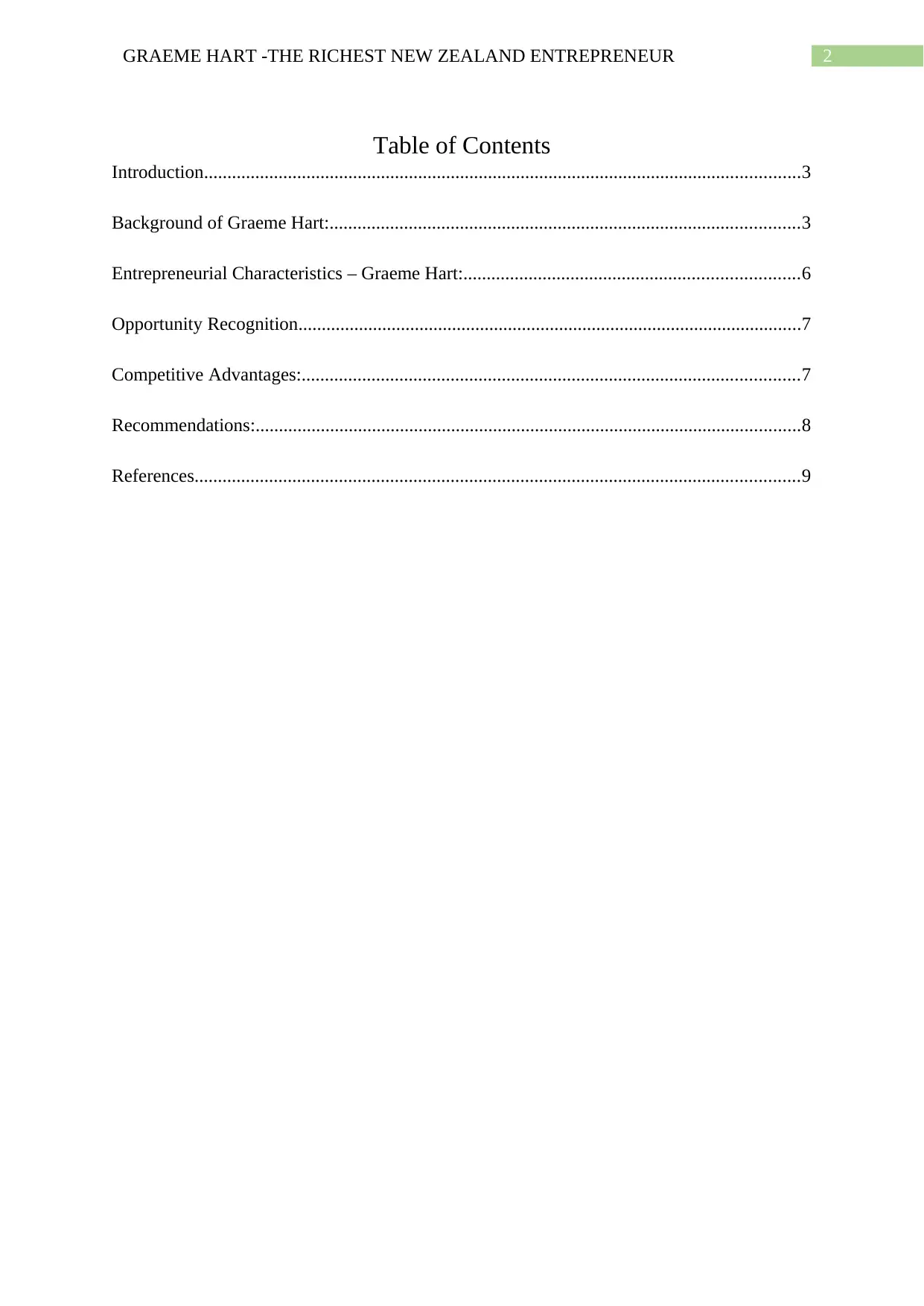
2GRAEME HART -THE RICHEST NEW ZEALAND ENTREPRENEUR
Table of Contents
Introduction................................................................................................................................3
Background of Graeme Hart:.....................................................................................................3
Entrepreneurial Characteristics – Graeme Hart:........................................................................6
Opportunity Recognition............................................................................................................7
Competitive Advantages:...........................................................................................................7
Recommendations:.....................................................................................................................8
References..................................................................................................................................9
Table of Contents
Introduction................................................................................................................................3
Background of Graeme Hart:.....................................................................................................3
Entrepreneurial Characteristics – Graeme Hart:........................................................................6
Opportunity Recognition............................................................................................................7
Competitive Advantages:...........................................................................................................7
Recommendations:.....................................................................................................................8
References..................................................................................................................................9
⊘ This is a preview!⊘
Do you want full access?
Subscribe today to unlock all pages.

Trusted by 1+ million students worldwide
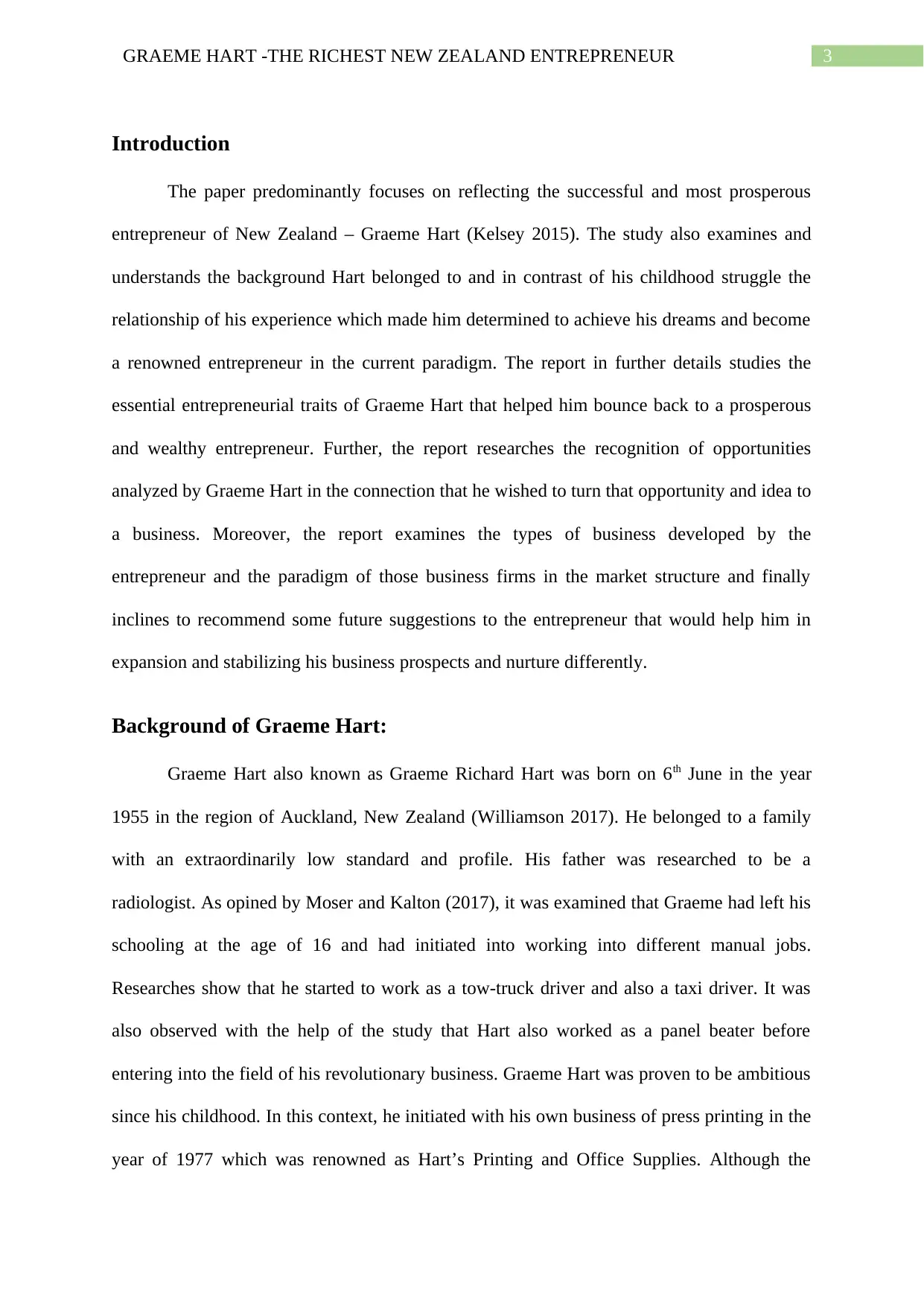
3GRAEME HART -THE RICHEST NEW ZEALAND ENTREPRENEUR
Introduction
The paper predominantly focuses on reflecting the successful and most prosperous
entrepreneur of New Zealand – Graeme Hart (Kelsey 2015). The study also examines and
understands the background Hart belonged to and in contrast of his childhood struggle the
relationship of his experience which made him determined to achieve his dreams and become
a renowned entrepreneur in the current paradigm. The report in further details studies the
essential entrepreneurial traits of Graeme Hart that helped him bounce back to a prosperous
and wealthy entrepreneur. Further, the report researches the recognition of opportunities
analyzed by Graeme Hart in the connection that he wished to turn that opportunity and idea to
a business. Moreover, the report examines the types of business developed by the
entrepreneur and the paradigm of those business firms in the market structure and finally
inclines to recommend some future suggestions to the entrepreneur that would help him in
expansion and stabilizing his business prospects and nurture differently.
Background of Graeme Hart:
Graeme Hart also known as Graeme Richard Hart was born on 6th June in the year
1955 in the region of Auckland, New Zealand (Williamson 2017). He belonged to a family
with an extraordinarily low standard and profile. His father was researched to be a
radiologist. As opined by Moser and Kalton (2017), it was examined that Graeme had left his
schooling at the age of 16 and had initiated into working into different manual jobs.
Researches show that he started to work as a tow-truck driver and also a taxi driver. It was
also observed with the help of the study that Hart also worked as a panel beater before
entering into the field of his revolutionary business. Graeme Hart was proven to be ambitious
since his childhood. In this context, he initiated with his own business of press printing in the
year of 1977 which was renowned as Hart’s Printing and Office Supplies. Although the
Introduction
The paper predominantly focuses on reflecting the successful and most prosperous
entrepreneur of New Zealand – Graeme Hart (Kelsey 2015). The study also examines and
understands the background Hart belonged to and in contrast of his childhood struggle the
relationship of his experience which made him determined to achieve his dreams and become
a renowned entrepreneur in the current paradigm. The report in further details studies the
essential entrepreneurial traits of Graeme Hart that helped him bounce back to a prosperous
and wealthy entrepreneur. Further, the report researches the recognition of opportunities
analyzed by Graeme Hart in the connection that he wished to turn that opportunity and idea to
a business. Moreover, the report examines the types of business developed by the
entrepreneur and the paradigm of those business firms in the market structure and finally
inclines to recommend some future suggestions to the entrepreneur that would help him in
expansion and stabilizing his business prospects and nurture differently.
Background of Graeme Hart:
Graeme Hart also known as Graeme Richard Hart was born on 6th June in the year
1955 in the region of Auckland, New Zealand (Williamson 2017). He belonged to a family
with an extraordinarily low standard and profile. His father was researched to be a
radiologist. As opined by Moser and Kalton (2017), it was examined that Graeme had left his
schooling at the age of 16 and had initiated into working into different manual jobs.
Researches show that he started to work as a tow-truck driver and also a taxi driver. It was
also observed with the help of the study that Hart also worked as a panel beater before
entering into the field of his revolutionary business. Graeme Hart was proven to be ambitious
since his childhood. In this context, he initiated with his own business of press printing in the
year of 1977 which was renowned as Hart’s Printing and Office Supplies. Although the
Paraphrase This Document
Need a fresh take? Get an instant paraphrase of this document with our AI Paraphraser
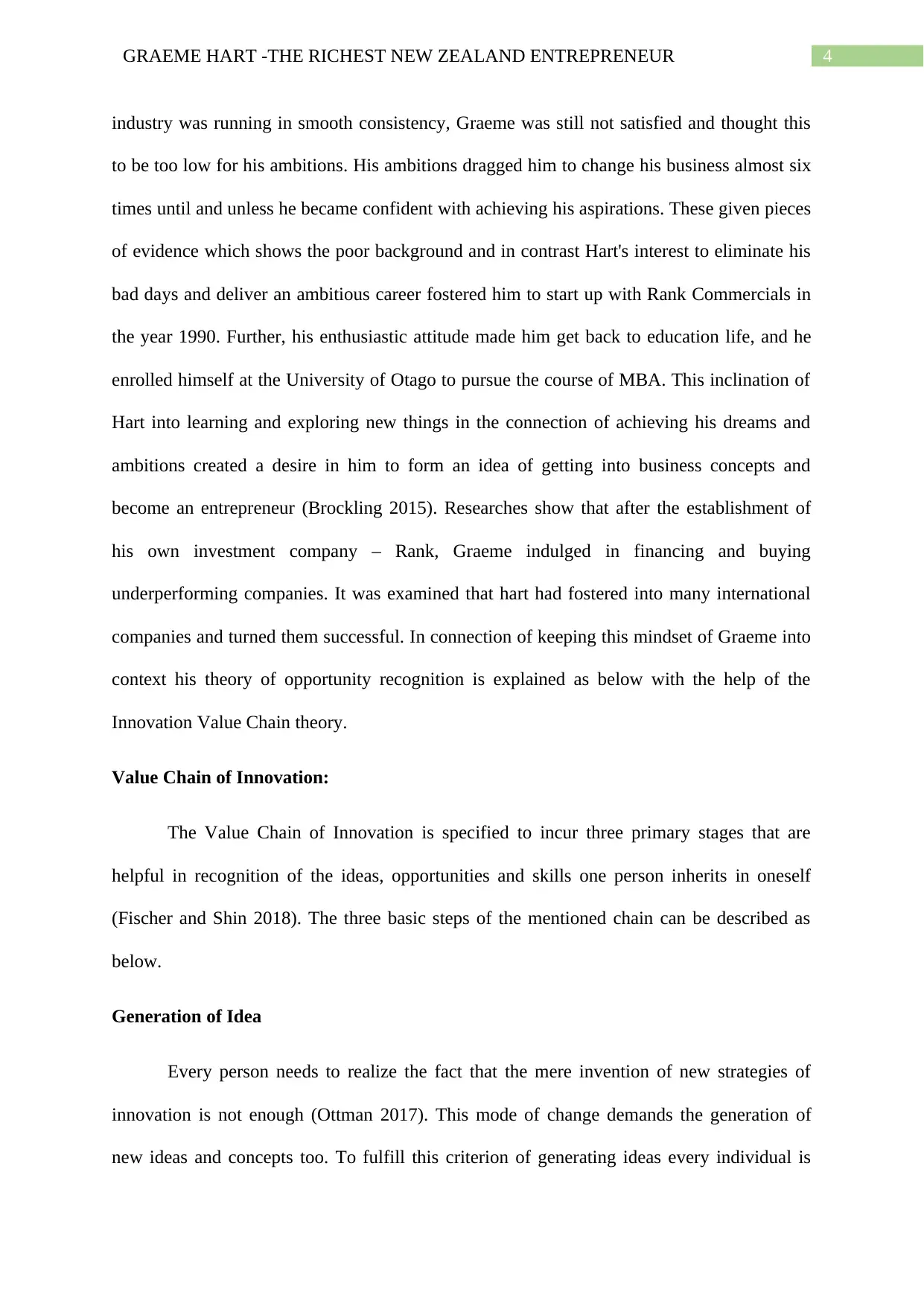
4GRAEME HART -THE RICHEST NEW ZEALAND ENTREPRENEUR
industry was running in smooth consistency, Graeme was still not satisfied and thought this
to be too low for his ambitions. His ambitions dragged him to change his business almost six
times until and unless he became confident with achieving his aspirations. These given pieces
of evidence which shows the poor background and in contrast Hart's interest to eliminate his
bad days and deliver an ambitious career fostered him to start up with Rank Commercials in
the year 1990. Further, his enthusiastic attitude made him get back to education life, and he
enrolled himself at the University of Otago to pursue the course of MBA. This inclination of
Hart into learning and exploring new things in the connection of achieving his dreams and
ambitions created a desire in him to form an idea of getting into business concepts and
become an entrepreneur (Brockling 2015). Researches show that after the establishment of
his own investment company – Rank, Graeme indulged in financing and buying
underperforming companies. It was examined that hart had fostered into many international
companies and turned them successful. In connection of keeping this mindset of Graeme into
context his theory of opportunity recognition is explained as below with the help of the
Innovation Value Chain theory.
Value Chain of Innovation:
The Value Chain of Innovation is specified to incur three primary stages that are
helpful in recognition of the ideas, opportunities and skills one person inherits in oneself
(Fischer and Shin 2018). The three basic steps of the mentioned chain can be described as
below.
Generation of Idea
Every person needs to realize the fact that the mere invention of new strategies of
innovation is not enough (Ottman 2017). This mode of change demands the generation of
new ideas and concepts too. To fulfill this criterion of generating ideas every individual is
industry was running in smooth consistency, Graeme was still not satisfied and thought this
to be too low for his ambitions. His ambitions dragged him to change his business almost six
times until and unless he became confident with achieving his aspirations. These given pieces
of evidence which shows the poor background and in contrast Hart's interest to eliminate his
bad days and deliver an ambitious career fostered him to start up with Rank Commercials in
the year 1990. Further, his enthusiastic attitude made him get back to education life, and he
enrolled himself at the University of Otago to pursue the course of MBA. This inclination of
Hart into learning and exploring new things in the connection of achieving his dreams and
ambitions created a desire in him to form an idea of getting into business concepts and
become an entrepreneur (Brockling 2015). Researches show that after the establishment of
his own investment company – Rank, Graeme indulged in financing and buying
underperforming companies. It was examined that hart had fostered into many international
companies and turned them successful. In connection of keeping this mindset of Graeme into
context his theory of opportunity recognition is explained as below with the help of the
Innovation Value Chain theory.
Value Chain of Innovation:
The Value Chain of Innovation is specified to incur three primary stages that are
helpful in recognition of the ideas, opportunities and skills one person inherits in oneself
(Fischer and Shin 2018). The three basic steps of the mentioned chain can be described as
below.
Generation of Idea
Every person needs to realize the fact that the mere invention of new strategies of
innovation is not enough (Ottman 2017). This mode of change demands the generation of
new ideas and concepts too. To fulfill this criterion of generating ideas every individual is
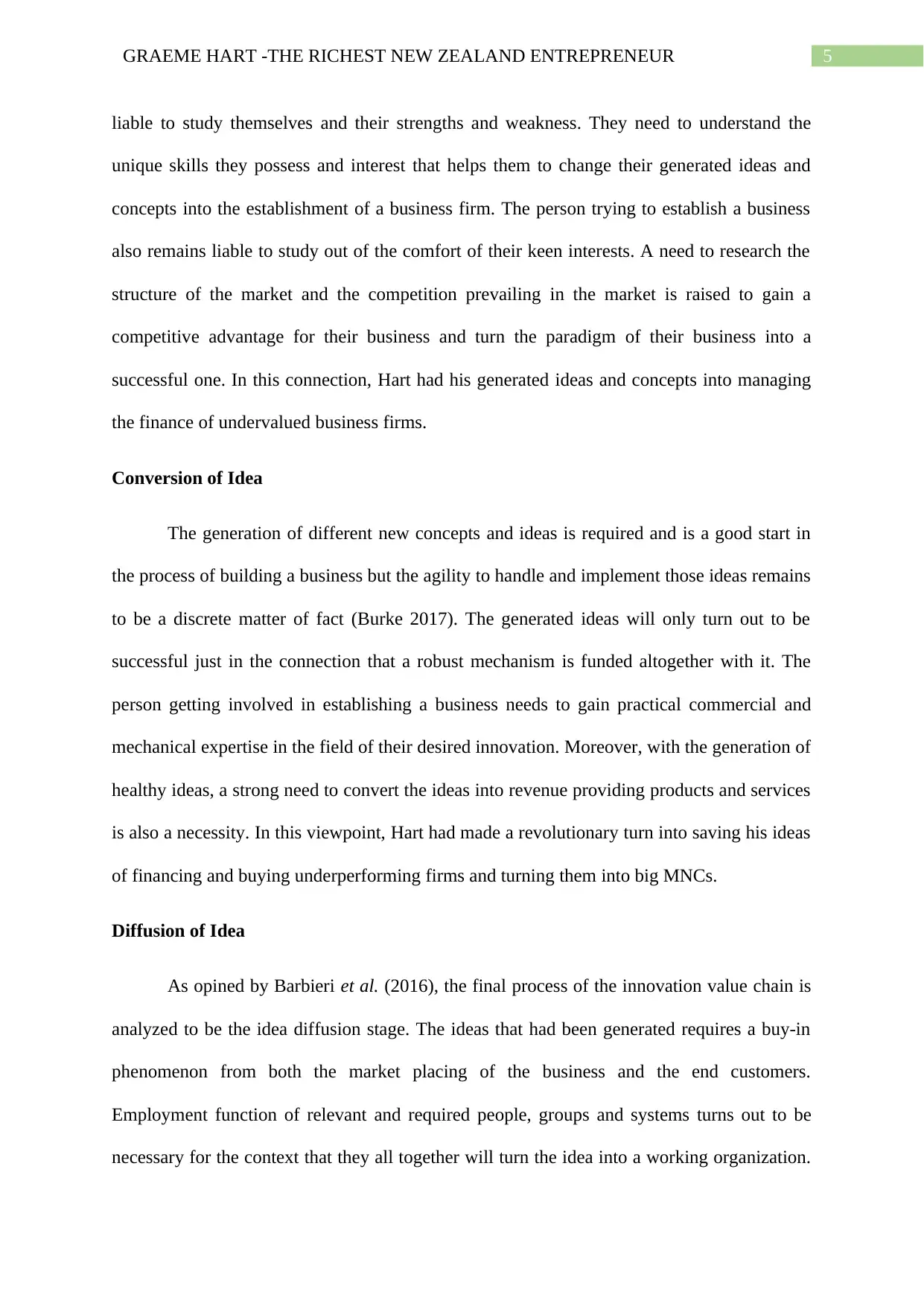
5GRAEME HART -THE RICHEST NEW ZEALAND ENTREPRENEUR
liable to study themselves and their strengths and weakness. They need to understand the
unique skills they possess and interest that helps them to change their generated ideas and
concepts into the establishment of a business firm. The person trying to establish a business
also remains liable to study out of the comfort of their keen interests. A need to research the
structure of the market and the competition prevailing in the market is raised to gain a
competitive advantage for their business and turn the paradigm of their business into a
successful one. In this connection, Hart had his generated ideas and concepts into managing
the finance of undervalued business firms.
Conversion of Idea
The generation of different new concepts and ideas is required and is a good start in
the process of building a business but the agility to handle and implement those ideas remains
to be a discrete matter of fact (Burke 2017). The generated ideas will only turn out to be
successful just in the connection that a robust mechanism is funded altogether with it. The
person getting involved in establishing a business needs to gain practical commercial and
mechanical expertise in the field of their desired innovation. Moreover, with the generation of
healthy ideas, a strong need to convert the ideas into revenue providing products and services
is also a necessity. In this viewpoint, Hart had made a revolutionary turn into saving his ideas
of financing and buying underperforming firms and turning them into big MNCs.
Diffusion of Idea
As opined by Barbieri et al. (2016), the final process of the innovation value chain is
analyzed to be the idea diffusion stage. The ideas that had been generated requires a buy-in
phenomenon from both the market placing of the business and the end customers.
Employment function of relevant and required people, groups and systems turns out to be
necessary for the context that they all together will turn the idea into a working organization.
liable to study themselves and their strengths and weakness. They need to understand the
unique skills they possess and interest that helps them to change their generated ideas and
concepts into the establishment of a business firm. The person trying to establish a business
also remains liable to study out of the comfort of their keen interests. A need to research the
structure of the market and the competition prevailing in the market is raised to gain a
competitive advantage for their business and turn the paradigm of their business into a
successful one. In this connection, Hart had his generated ideas and concepts into managing
the finance of undervalued business firms.
Conversion of Idea
The generation of different new concepts and ideas is required and is a good start in
the process of building a business but the agility to handle and implement those ideas remains
to be a discrete matter of fact (Burke 2017). The generated ideas will only turn out to be
successful just in the connection that a robust mechanism is funded altogether with it. The
person getting involved in establishing a business needs to gain practical commercial and
mechanical expertise in the field of their desired innovation. Moreover, with the generation of
healthy ideas, a strong need to convert the ideas into revenue providing products and services
is also a necessity. In this viewpoint, Hart had made a revolutionary turn into saving his ideas
of financing and buying underperforming firms and turning them into big MNCs.
Diffusion of Idea
As opined by Barbieri et al. (2016), the final process of the innovation value chain is
analyzed to be the idea diffusion stage. The ideas that had been generated requires a buy-in
phenomenon from both the market placing of the business and the end customers.
Employment function of relevant and required people, groups and systems turns out to be
necessary for the context that they all together will turn the idea into a working organization.
⊘ This is a preview!⊘
Do you want full access?
Subscribe today to unlock all pages.

Trusted by 1+ million students worldwide
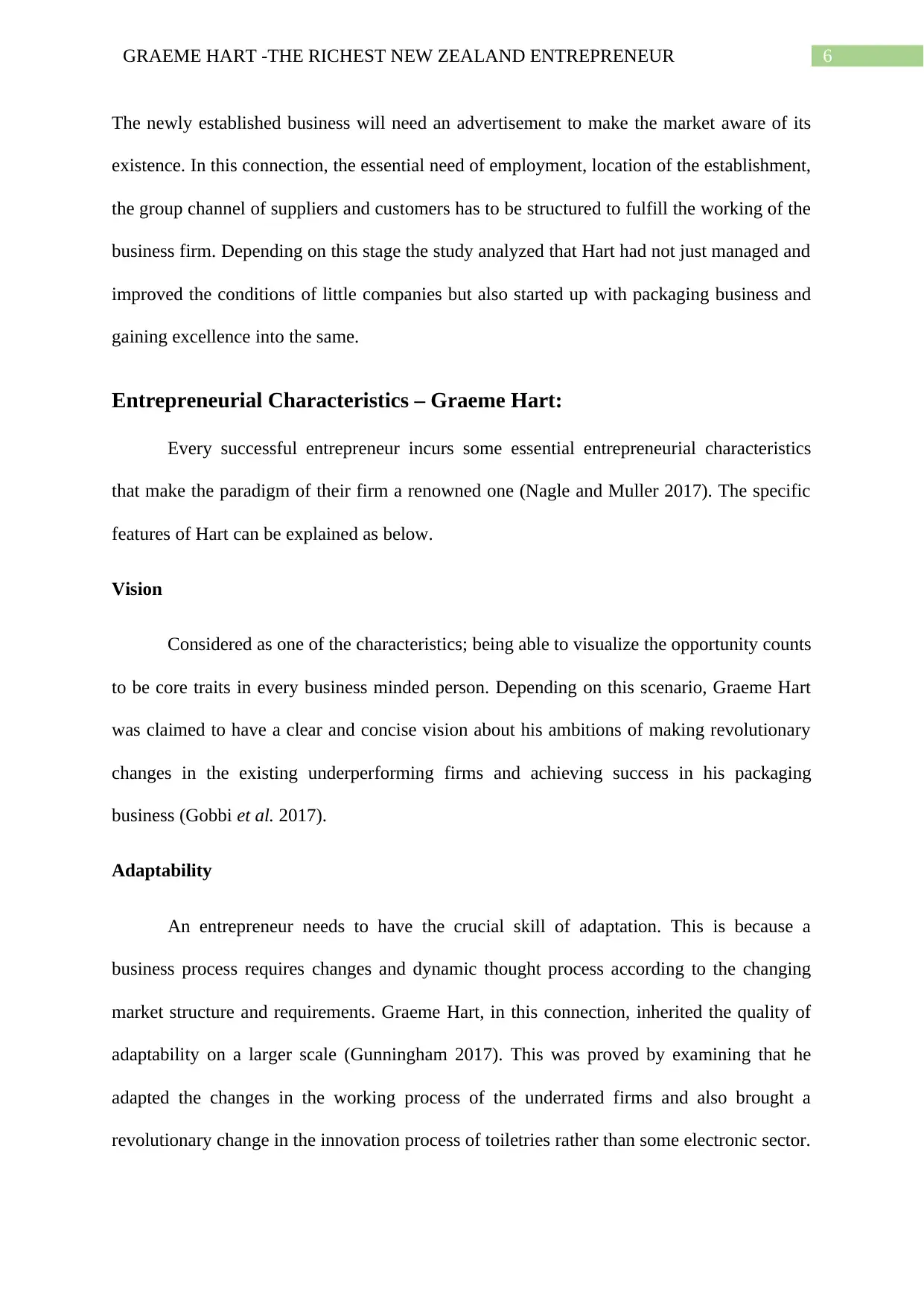
6GRAEME HART -THE RICHEST NEW ZEALAND ENTREPRENEUR
The newly established business will need an advertisement to make the market aware of its
existence. In this connection, the essential need of employment, location of the establishment,
the group channel of suppliers and customers has to be structured to fulfill the working of the
business firm. Depending on this stage the study analyzed that Hart had not just managed and
improved the conditions of little companies but also started up with packaging business and
gaining excellence into the same.
Entrepreneurial Characteristics – Graeme Hart:
Every successful entrepreneur incurs some essential entrepreneurial characteristics
that make the paradigm of their firm a renowned one (Nagle and Muller 2017). The specific
features of Hart can be explained as below.
Vision
Considered as one of the characteristics; being able to visualize the opportunity counts
to be core traits in every business minded person. Depending on this scenario, Graeme Hart
was claimed to have a clear and concise vision about his ambitions of making revolutionary
changes in the existing underperforming firms and achieving success in his packaging
business (Gobbi et al. 2017).
Adaptability
An entrepreneur needs to have the crucial skill of adaptation. This is because a
business process requires changes and dynamic thought process according to the changing
market structure and requirements. Graeme Hart, in this connection, inherited the quality of
adaptability on a larger scale (Gunningham 2017). This was proved by examining that he
adapted the changes in the working process of the underrated firms and also brought a
revolutionary change in the innovation process of toiletries rather than some electronic sector.
The newly established business will need an advertisement to make the market aware of its
existence. In this connection, the essential need of employment, location of the establishment,
the group channel of suppliers and customers has to be structured to fulfill the working of the
business firm. Depending on this stage the study analyzed that Hart had not just managed and
improved the conditions of little companies but also started up with packaging business and
gaining excellence into the same.
Entrepreneurial Characteristics – Graeme Hart:
Every successful entrepreneur incurs some essential entrepreneurial characteristics
that make the paradigm of their firm a renowned one (Nagle and Muller 2017). The specific
features of Hart can be explained as below.
Vision
Considered as one of the characteristics; being able to visualize the opportunity counts
to be core traits in every business minded person. Depending on this scenario, Graeme Hart
was claimed to have a clear and concise vision about his ambitions of making revolutionary
changes in the existing underperforming firms and achieving success in his packaging
business (Gobbi et al. 2017).
Adaptability
An entrepreneur needs to have the crucial skill of adaptation. This is because a
business process requires changes and dynamic thought process according to the changing
market structure and requirements. Graeme Hart, in this connection, inherited the quality of
adaptability on a larger scale (Gunningham 2017). This was proved by examining that he
adapted the changes in the working process of the underrated firms and also brought a
revolutionary change in the innovation process of toiletries rather than some electronic sector.
Paraphrase This Document
Need a fresh take? Get an instant paraphrase of this document with our AI Paraphraser
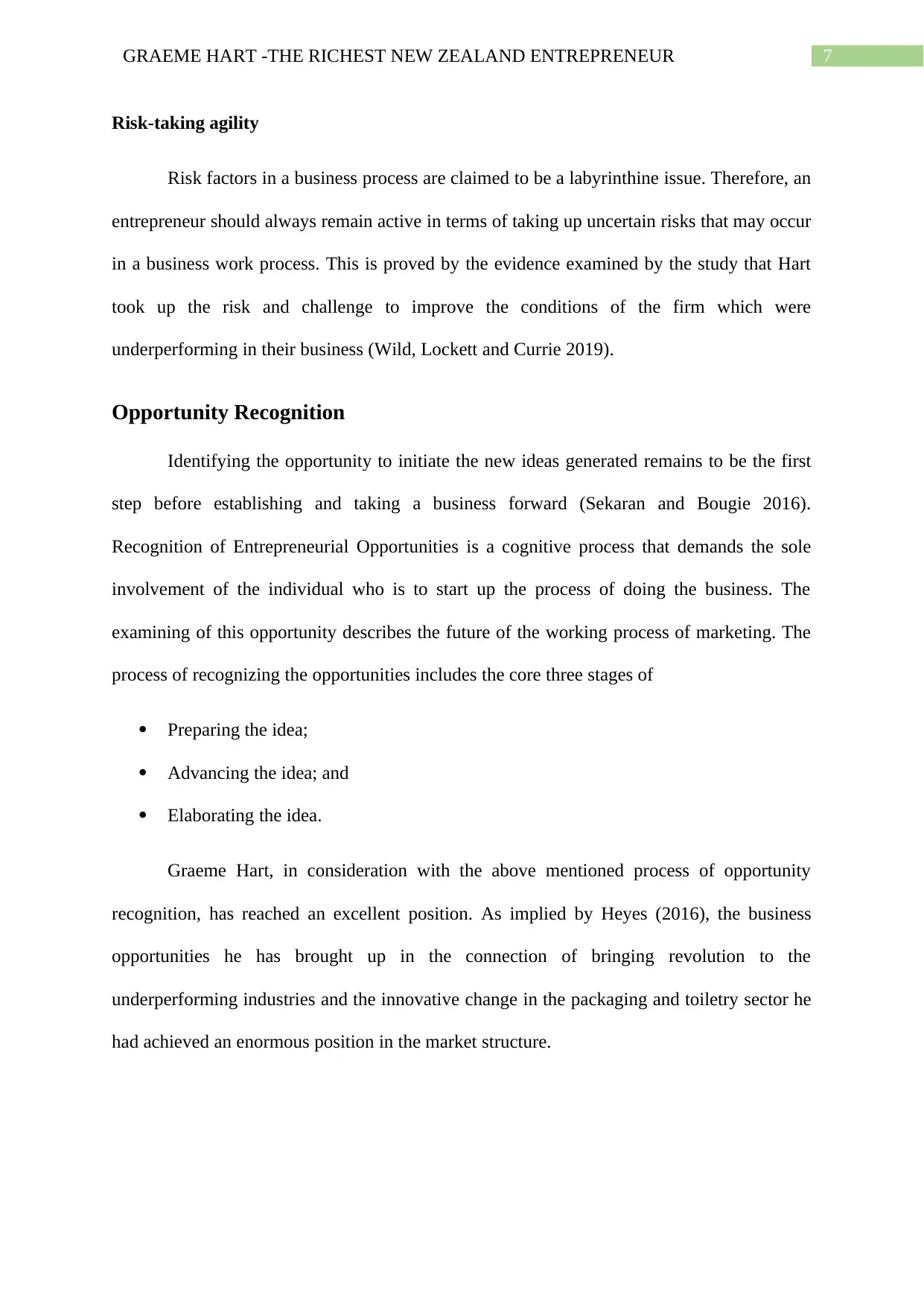
7GRAEME HART -THE RICHEST NEW ZEALAND ENTREPRENEUR
Risk-taking agility
Risk factors in a business process are claimed to be a labyrinthine issue. Therefore, an
entrepreneur should always remain active in terms of taking up uncertain risks that may occur
in a business work process. This is proved by the evidence examined by the study that Hart
took up the risk and challenge to improve the conditions of the firm which were
underperforming in their business (Wild, Lockett and Currie 2019).
Opportunity Recognition
Identifying the opportunity to initiate the new ideas generated remains to be the first
step before establishing and taking a business forward (Sekaran and Bougie 2016).
Recognition of Entrepreneurial Opportunities is a cognitive process that demands the sole
involvement of the individual who is to start up the process of doing the business. The
examining of this opportunity describes the future of the working process of marketing. The
process of recognizing the opportunities includes the core three stages of
Preparing the idea;
Advancing the idea; and
Elaborating the idea.
Graeme Hart, in consideration with the above mentioned process of opportunity
recognition, has reached an excellent position. As implied by Heyes (2016), the business
opportunities he has brought up in the connection of bringing revolution to the
underperforming industries and the innovative change in the packaging and toiletry sector he
had achieved an enormous position in the market structure.
Risk-taking agility
Risk factors in a business process are claimed to be a labyrinthine issue. Therefore, an
entrepreneur should always remain active in terms of taking up uncertain risks that may occur
in a business work process. This is proved by the evidence examined by the study that Hart
took up the risk and challenge to improve the conditions of the firm which were
underperforming in their business (Wild, Lockett and Currie 2019).
Opportunity Recognition
Identifying the opportunity to initiate the new ideas generated remains to be the first
step before establishing and taking a business forward (Sekaran and Bougie 2016).
Recognition of Entrepreneurial Opportunities is a cognitive process that demands the sole
involvement of the individual who is to start up the process of doing the business. The
examining of this opportunity describes the future of the working process of marketing. The
process of recognizing the opportunities includes the core three stages of
Preparing the idea;
Advancing the idea; and
Elaborating the idea.
Graeme Hart, in consideration with the above mentioned process of opportunity
recognition, has reached an excellent position. As implied by Heyes (2016), the business
opportunities he has brought up in the connection of bringing revolution to the
underperforming industries and the innovative change in the packaging and toiletry sector he
had achieved an enormous position in the market structure.
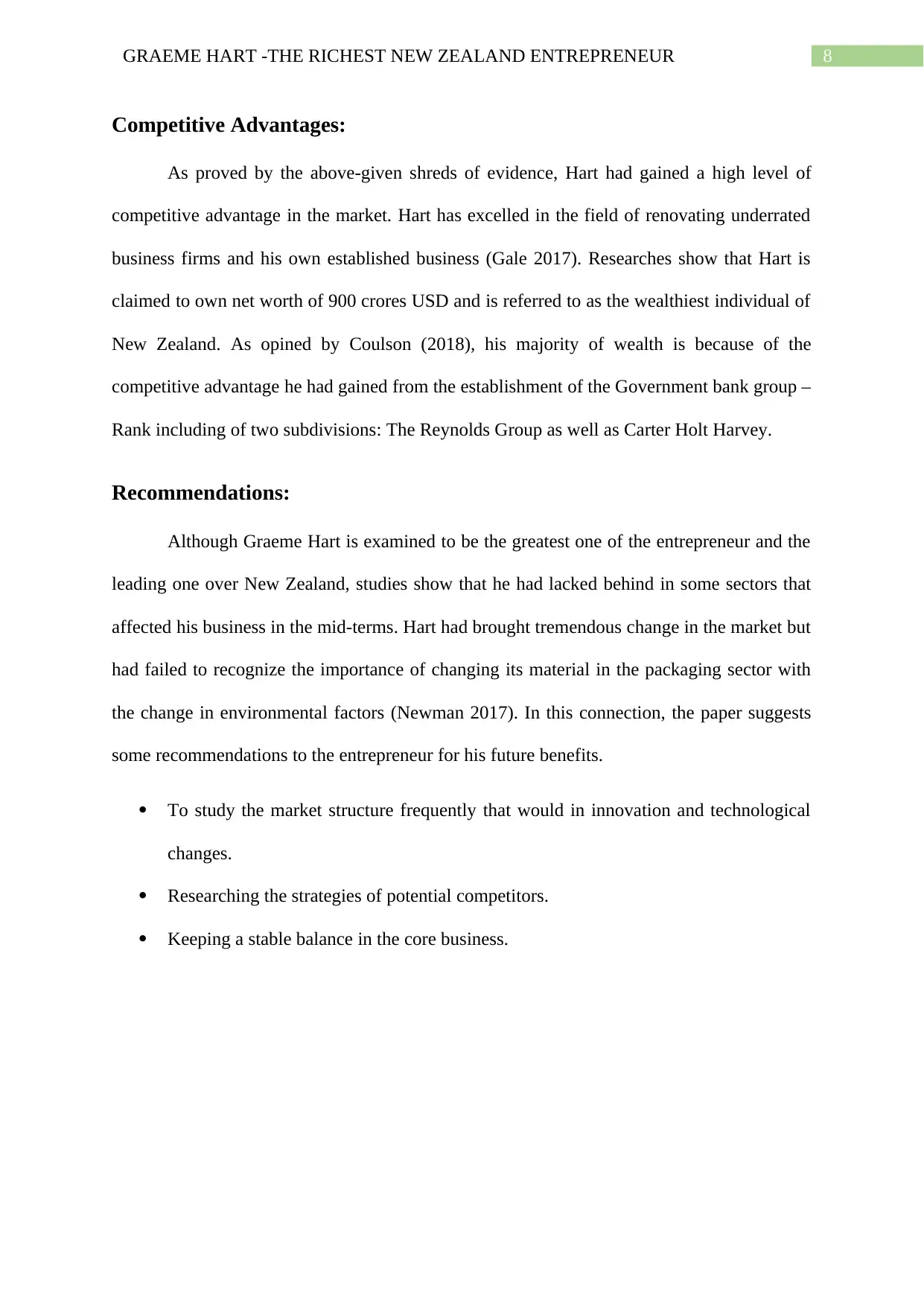
8GRAEME HART -THE RICHEST NEW ZEALAND ENTREPRENEUR
Competitive Advantages:
As proved by the above-given shreds of evidence, Hart had gained a high level of
competitive advantage in the market. Hart has excelled in the field of renovating underrated
business firms and his own established business (Gale 2017). Researches show that Hart is
claimed to own net worth of 900 crores USD and is referred to as the wealthiest individual of
New Zealand. As opined by Coulson (2018), his majority of wealth is because of the
competitive advantage he had gained from the establishment of the Government bank group –
Rank including of two subdivisions: The Reynolds Group as well as Carter Holt Harvey.
Recommendations:
Although Graeme Hart is examined to be the greatest one of the entrepreneur and the
leading one over New Zealand, studies show that he had lacked behind in some sectors that
affected his business in the mid-terms. Hart had brought tremendous change in the market but
had failed to recognize the importance of changing its material in the packaging sector with
the change in environmental factors (Newman 2017). In this connection, the paper suggests
some recommendations to the entrepreneur for his future benefits.
To study the market structure frequently that would in innovation and technological
changes.
Researching the strategies of potential competitors.
Keeping a stable balance in the core business.
Competitive Advantages:
As proved by the above-given shreds of evidence, Hart had gained a high level of
competitive advantage in the market. Hart has excelled in the field of renovating underrated
business firms and his own established business (Gale 2017). Researches show that Hart is
claimed to own net worth of 900 crores USD and is referred to as the wealthiest individual of
New Zealand. As opined by Coulson (2018), his majority of wealth is because of the
competitive advantage he had gained from the establishment of the Government bank group –
Rank including of two subdivisions: The Reynolds Group as well as Carter Holt Harvey.
Recommendations:
Although Graeme Hart is examined to be the greatest one of the entrepreneur and the
leading one over New Zealand, studies show that he had lacked behind in some sectors that
affected his business in the mid-terms. Hart had brought tremendous change in the market but
had failed to recognize the importance of changing its material in the packaging sector with
the change in environmental factors (Newman 2017). In this connection, the paper suggests
some recommendations to the entrepreneur for his future benefits.
To study the market structure frequently that would in innovation and technological
changes.
Researching the strategies of potential competitors.
Keeping a stable balance in the core business.
⊘ This is a preview!⊘
Do you want full access?
Subscribe today to unlock all pages.

Trusted by 1+ million students worldwide
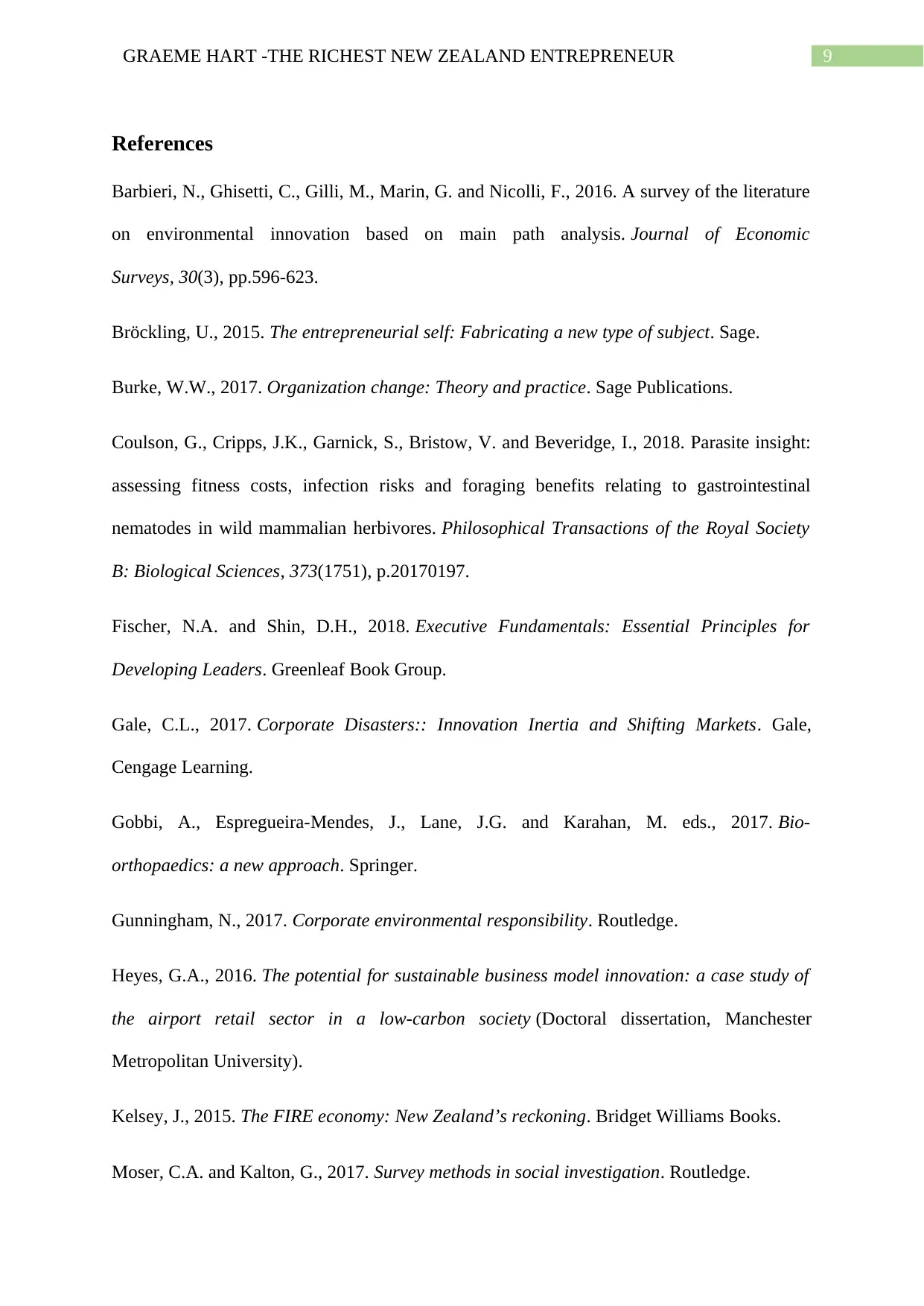
9GRAEME HART -THE RICHEST NEW ZEALAND ENTREPRENEUR
References
Barbieri, N., Ghisetti, C., Gilli, M., Marin, G. and Nicolli, F., 2016. A survey of the literature
on environmental innovation based on main path analysis. Journal of Economic
Surveys, 30(3), pp.596-623.
Bröckling, U., 2015. The entrepreneurial self: Fabricating a new type of subject. Sage.
Burke, W.W., 2017. Organization change: Theory and practice. Sage Publications.
Coulson, G., Cripps, J.K., Garnick, S., Bristow, V. and Beveridge, I., 2018. Parasite insight:
assessing fitness costs, infection risks and foraging benefits relating to gastrointestinal
nematodes in wild mammalian herbivores. Philosophical Transactions of the Royal Society
B: Biological Sciences, 373(1751), p.20170197.
Fischer, N.A. and Shin, D.H., 2018. Executive Fundamentals: Essential Principles for
Developing Leaders. Greenleaf Book Group.
Gale, C.L., 2017. Corporate Disasters:: Innovation Inertia and Shifting Markets. Gale,
Cengage Learning.
Gobbi, A., Espregueira-Mendes, J., Lane, J.G. and Karahan, M. eds., 2017. Bio-
orthopaedics: a new approach. Springer.
Gunningham, N., 2017. Corporate environmental responsibility. Routledge.
Heyes, G.A., 2016. The potential for sustainable business model innovation: a case study of
the airport retail sector in a low-carbon society (Doctoral dissertation, Manchester
Metropolitan University).
Kelsey, J., 2015. The FIRE economy: New Zealand’s reckoning. Bridget Williams Books.
Moser, C.A. and Kalton, G., 2017. Survey methods in social investigation. Routledge.
References
Barbieri, N., Ghisetti, C., Gilli, M., Marin, G. and Nicolli, F., 2016. A survey of the literature
on environmental innovation based on main path analysis. Journal of Economic
Surveys, 30(3), pp.596-623.
Bröckling, U., 2015. The entrepreneurial self: Fabricating a new type of subject. Sage.
Burke, W.W., 2017. Organization change: Theory and practice. Sage Publications.
Coulson, G., Cripps, J.K., Garnick, S., Bristow, V. and Beveridge, I., 2018. Parasite insight:
assessing fitness costs, infection risks and foraging benefits relating to gastrointestinal
nematodes in wild mammalian herbivores. Philosophical Transactions of the Royal Society
B: Biological Sciences, 373(1751), p.20170197.
Fischer, N.A. and Shin, D.H., 2018. Executive Fundamentals: Essential Principles for
Developing Leaders. Greenleaf Book Group.
Gale, C.L., 2017. Corporate Disasters:: Innovation Inertia and Shifting Markets. Gale,
Cengage Learning.
Gobbi, A., Espregueira-Mendes, J., Lane, J.G. and Karahan, M. eds., 2017. Bio-
orthopaedics: a new approach. Springer.
Gunningham, N., 2017. Corporate environmental responsibility. Routledge.
Heyes, G.A., 2016. The potential for sustainable business model innovation: a case study of
the airport retail sector in a low-carbon society (Doctoral dissertation, Manchester
Metropolitan University).
Kelsey, J., 2015. The FIRE economy: New Zealand’s reckoning. Bridget Williams Books.
Moser, C.A. and Kalton, G., 2017. Survey methods in social investigation. Routledge.
Paraphrase This Document
Need a fresh take? Get an instant paraphrase of this document with our AI Paraphraser
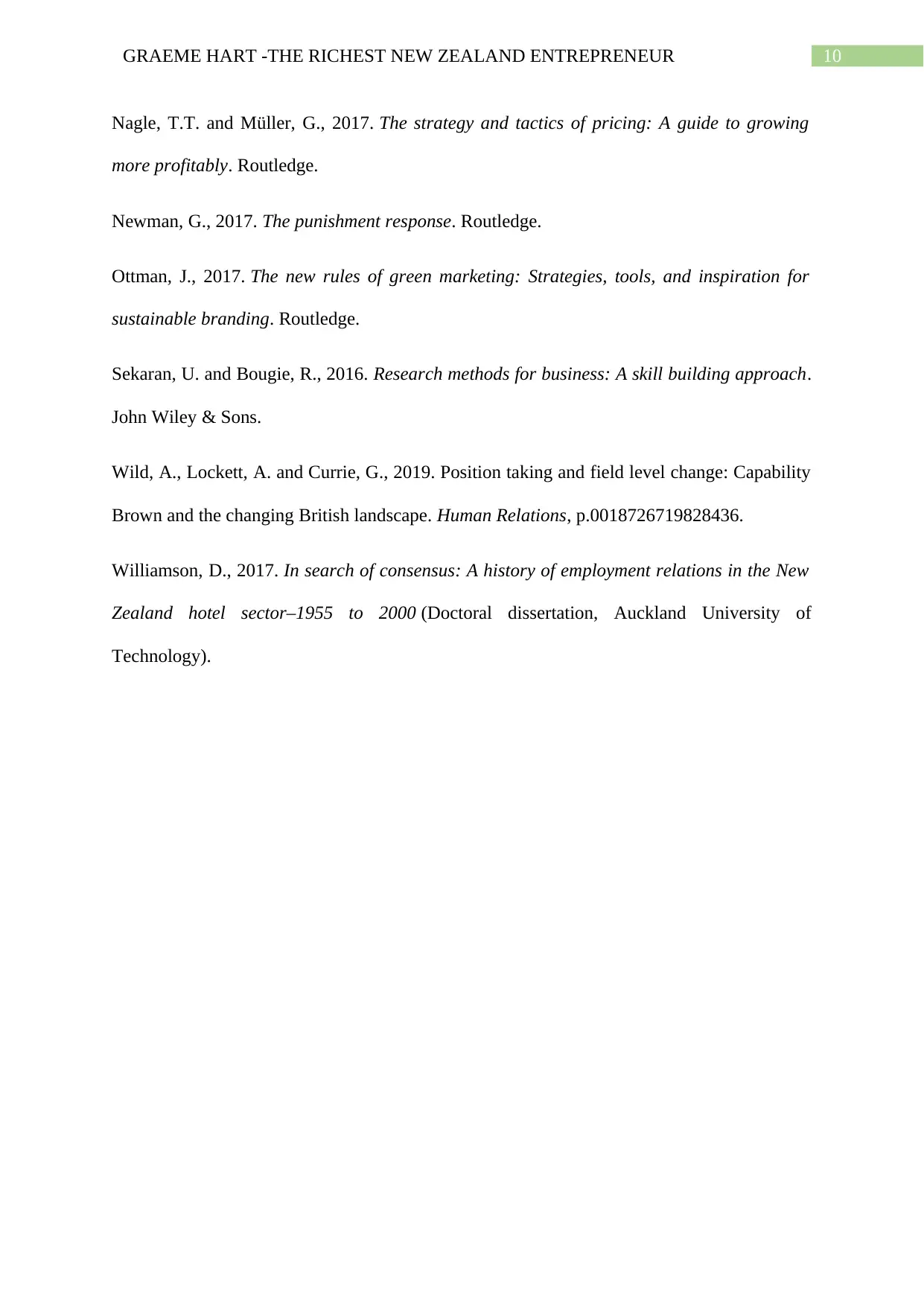
10GRAEME HART -THE RICHEST NEW ZEALAND ENTREPRENEUR
Nagle, T.T. and Müller, G., 2017. The strategy and tactics of pricing: A guide to growing
more profitably. Routledge.
Newman, G., 2017. The punishment response. Routledge.
Ottman, J., 2017. The new rules of green marketing: Strategies, tools, and inspiration for
sustainable branding. Routledge.
Sekaran, U. and Bougie, R., 2016. Research methods for business: A skill building approach.
John Wiley & Sons.
Wild, A., Lockett, A. and Currie, G., 2019. Position taking and field level change: Capability
Brown and the changing British landscape. Human Relations, p.0018726719828436.
Williamson, D., 2017. In search of consensus: A history of employment relations in the New
Zealand hotel sector–1955 to 2000 (Doctoral dissertation, Auckland University of
Technology).
Nagle, T.T. and Müller, G., 2017. The strategy and tactics of pricing: A guide to growing
more profitably. Routledge.
Newman, G., 2017. The punishment response. Routledge.
Ottman, J., 2017. The new rules of green marketing: Strategies, tools, and inspiration for
sustainable branding. Routledge.
Sekaran, U. and Bougie, R., 2016. Research methods for business: A skill building approach.
John Wiley & Sons.
Wild, A., Lockett, A. and Currie, G., 2019. Position taking and field level change: Capability
Brown and the changing British landscape. Human Relations, p.0018726719828436.
Williamson, D., 2017. In search of consensus: A history of employment relations in the New
Zealand hotel sector–1955 to 2000 (Doctoral dissertation, Auckland University of
Technology).
1 out of 11
Related Documents
Your All-in-One AI-Powered Toolkit for Academic Success.
+13062052269
info@desklib.com
Available 24*7 on WhatsApp / Email
![[object Object]](/_next/static/media/star-bottom.7253800d.svg)
Unlock your academic potential
Copyright © 2020–2025 A2Z Services. All Rights Reserved. Developed and managed by ZUCOL.




